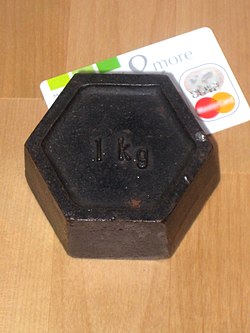Kilograms
| Kilogram | |
|---|---|

Domestic-quality one-kilogram cast iron weight, shaped in accordance with OIML recommendation R52 for cast-iron hexagonal weights, alongside a credit card for scale
|
|
| Unit system | SI unit |
| Unit of | Mass |
| Symbol | kg |
| 1 kg in ... | ... is equal to ... |
| Avoirdupois | ≈ 2.205 pounds |
| Natural units |
≈ 4.59×107 Planck masses 1.356392608(60)×1050 hertz |
|
|
|
|
|
|
|
|
|
|
|
|
|
|
|
|
|
|
|
|
|
|
|
|
|
|
|
|
|
The kilogram or kilogramme (SI unit symbol: kg) is the base unit of mass in the International System of Units (SI) (the Metric system) and is defined as being equal to the mass of the International Prototype of the Kilogram (IPK, also known as "Le Grand K" or "Big K").
The avoirdupois (or international) pound, used in both the imperial and US customary systems, is defined as exactly 0.45359237 kg, making one kilogram approximately equal to 2.2046 avoirdupois pounds. Other traditional units of weight and mass around the world are also defined in terms of the kilogram, making the IPK the primary standard for virtually all units of mass on Earth.
The gram, 1/1000 of a kilogram, was provisionally defined in 1795 as the mass of one cubic centimeter of water at the melting point of ice. The final kilogram, manufactured as a prototype in 1799 and from which the IPK was derived in 1875, had a mass equal to the mass of 1 dm3 of water at its maximum density, approximately 4 °C.
The kilogram is the only SI base unit with an SI prefix ("kilo", symbol "k") as part of its name. It is also the only SI unit that is still directly defined by an artifact rather than a fundamental physical property that can be reproduced in different laboratories. Three other base units (cd, A, mol) and 17 derived units (N, Pa, J, W, C, V, F, Ω, S, Wb, T, H, kat, Gy, Sv, lm, lx) in the SI system are defined relative to the kilogram, so its stability is important. Only 8 other units do not require the kilogram in their definition: temperature (K, °C), time and frequency (s, Hz, Bq), length (m), and angle (rad, sr).
...
Wikipedia
